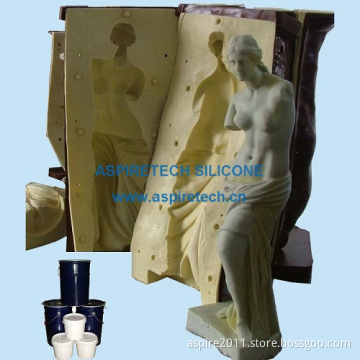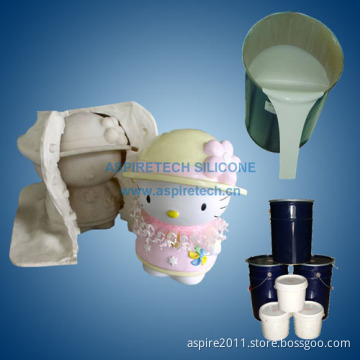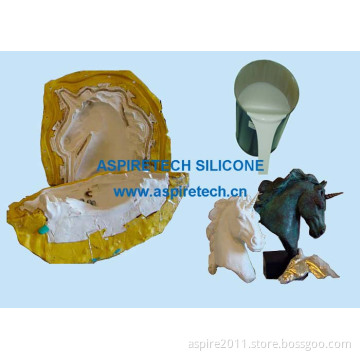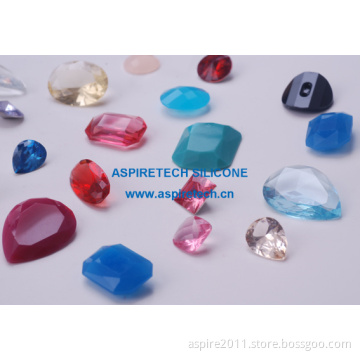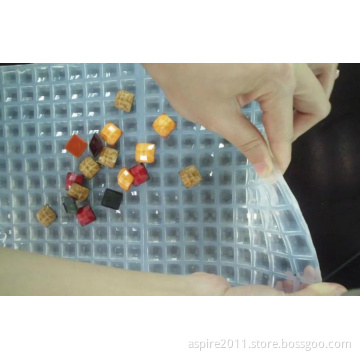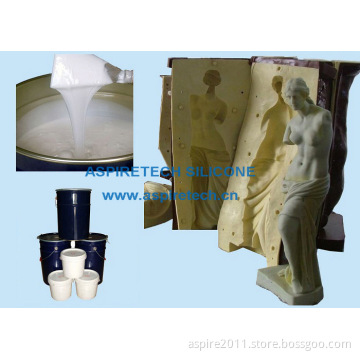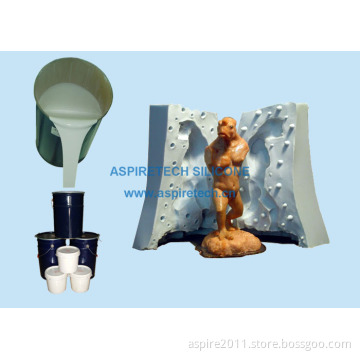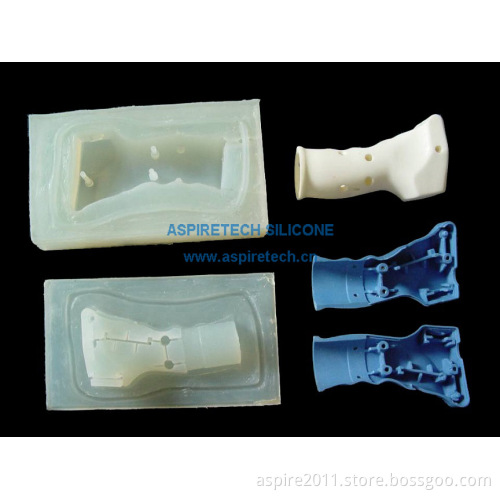
Addition Cure Mold Making Silicone Rubber (3019-AB)
- Payment Type:
- T/T, Western Union
Quantity:
Your message must be between 20 to 2000 characters
Contact NowBasic Info
Basic Info
| Place of Origin: | Zhuhai, China |
|---|---|
| Payment Type: | T/T, Western Union |
Product Description
Product Description
Description:
LSR-3019 is pourable two component RTV addition/platinum cure type translucent silicone rubber compounds for mold making. The two component system consists of a base (Part A) and curing agent/catalyst (Part B). After mixing parts 'A' and 'B' in the correct proportions, the system will cure at ambient temperatures within 24 hours by an addition reaction, and the rate of cure can be accelerated by heat. The cured rubber exhibits excellent physical and electrical properties.
Applications:
LSR-3019 is suitable for applications where very accurate dimensional reproduction is required, (such us rapid prototyping and model making, it produce exactitude moulds of complicated parts, precisely reproducing the dimensions of the original part. ) And also where higher temperature tolerance is required or where the maximum of repetitive releases will be possible.
Can be used for casting a range of materials, plaster, polyurethane, polyester and other reactive resins, concrete the materials typically used.
Features:
Addition cure silicone rubber is a more advanced type of RTV silicone than the more cost effective "condensation cure" silicone. It has many merits, such us:
High dimensional stability
Very low shrinkage - less than 0.1%
Fine detail reproduction
Translucent
High tear and tensile strength
Curing accelerated by heat
High chemical resistance (PU)
How to use
1. Preparation:
Certain contaminants found in mold-making operations can prevent curing. The original or pattern to be molded should be thoroughly cleaned to remove surface contaminants. If necessary, and in particular with porous substrates, a suitable release agent such as petroleum jelly or soap solution should then be wiped or sprayed to facilitate release.
2. Weighting:
Weigh a required amount of A and B parts by weight at the ration of 10 to 1 (A to B) into a clean plastic or metal container. Note that the weight of the bases and catalyst must be weighed accurately.
A sufficiently large container permits degassing without overflow. It is approximately 3-4 times the volume of base compound to be used.
3. Mixing:
Mix thoroughly. Fully stir until the curing agent is completely dispersed in the base, using the color contrast to achieve homogeneity.
4. De-gassing:
Stop the mixer and scrape the vessel walls a few times. To prevent imperfections due to bubbles in the cured rubber, it is strongly recommended that entrapped air be removed by using intermittent evacuation in a vacuum chamber for a few minutes, allowing the mix to completely expand and then collapse.
5. Pouring and Curing:
If the mix be inspected and free of air bubbles, pour the mixed base and catalyst as soon as possible onto the original, avoiding air entrapment. The catalyzed material will cure to a firm, flexible rubber within 24 hours at room temperature and then the mold can be removed.
Silicone rubber remains a flowable, pourable material for 1~2 hours after the curing agent is added at room temperature. And the rate of cure can be accelerated by heating. The following table offers a guide to the rate of cure at various temperatures:
Temperature, ° C Curing Time
25° C 24 hours
60° C ~ 70° C 2 ~ 3 hours
120° C 30 minutes
Inhibition of Cure:
Among materials found to cause inhibition are amines, nitrogen, sulfur, phosphorus and arsenic containing, as are organometallic salts-containing compounds used in condensation cure silicones. Surfaces previously in contact with any of the above materials may also cause inhibition.
6. Mold Performance & Storage:
The physical life of the mold depends on how you use it (working temperature, materials cast, frequency, etc. ).
Molds should be stored on a level surface in a cool, dry environment.
LSR-3019 is pourable two component RTV addition/platinum cure type translucent silicone rubber compounds for mold making. The two component system consists of a base (Part A) and curing agent/catalyst (Part B). After mixing parts 'A' and 'B' in the correct proportions, the system will cure at ambient temperatures within 24 hours by an addition reaction, and the rate of cure can be accelerated by heat. The cured rubber exhibits excellent physical and electrical properties.
Applications:
LSR-3019 is suitable for applications where very accurate dimensional reproduction is required, (such us rapid prototyping and model making, it produce exactitude moulds of complicated parts, precisely reproducing the dimensions of the original part. ) And also where higher temperature tolerance is required or where the maximum of repetitive releases will be possible.
Can be used for casting a range of materials, plaster, polyurethane, polyester and other reactive resins, concrete the materials typically used.
Features:
Addition cure silicone rubber is a more advanced type of RTV silicone than the more cost effective "condensation cure" silicone. It has many merits, such us:
High dimensional stability
Very low shrinkage - less than 0.1%
Fine detail reproduction
Translucent
High tear and tensile strength
Curing accelerated by heat
High chemical resistance (PU)
How to use
1. Preparation:
Certain contaminants found in mold-making operations can prevent curing. The original or pattern to be molded should be thoroughly cleaned to remove surface contaminants. If necessary, and in particular with porous substrates, a suitable release agent such as petroleum jelly or soap solution should then be wiped or sprayed to facilitate release.
2. Weighting:
Weigh a required amount of A and B parts by weight at the ration of 10 to 1 (A to B) into a clean plastic or metal container. Note that the weight of the bases and catalyst must be weighed accurately.
A sufficiently large container permits degassing without overflow. It is approximately 3-4 times the volume of base compound to be used.
3. Mixing:
Mix thoroughly. Fully stir until the curing agent is completely dispersed in the base, using the color contrast to achieve homogeneity.
4. De-gassing:
Stop the mixer and scrape the vessel walls a few times. To prevent imperfections due to bubbles in the cured rubber, it is strongly recommended that entrapped air be removed by using intermittent evacuation in a vacuum chamber for a few minutes, allowing the mix to completely expand and then collapse.
5. Pouring and Curing:
If the mix be inspected and free of air bubbles, pour the mixed base and catalyst as soon as possible onto the original, avoiding air entrapment. The catalyzed material will cure to a firm, flexible rubber within 24 hours at room temperature and then the mold can be removed.
Silicone rubber remains a flowable, pourable material for 1~2 hours after the curing agent is added at room temperature. And the rate of cure can be accelerated by heating. The following table offers a guide to the rate of cure at various temperatures:
Temperature, ° C Curing Time
25° C 24 hours
60° C ~ 70° C 2 ~ 3 hours
120° C 30 minutes
Inhibition of Cure:
Among materials found to cause inhibition are amines, nitrogen, sulfur, phosphorus and arsenic containing, as are organometallic salts-containing compounds used in condensation cure silicones. Surfaces previously in contact with any of the above materials may also cause inhibition.
6. Mold Performance & Storage:
The physical life of the mold depends on how you use it (working temperature, materials cast, frequency, etc. ).
Molds should be stored on a level surface in a cool, dry environment.
Related Keywords
Related Keywords
You May Also Like
You May Also Like

